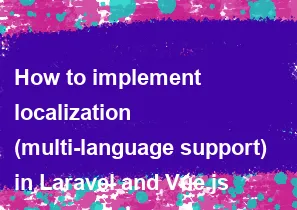How to implement localization (multi-language support) in Laravel and Vue.js

Implementing localization, or multi-language support, in a Laravel and Vue.js application involves several steps. Laravel provides a robust localization system, and Vue.js can be integrated seamlessly for client-side translations. Here's a step-by-step guide on how you can achieve this:
1. Set Up Laravel Localization:
a. Configure Laravel Localization:
Laravel uses language files to store translations. Create language files for each language you want to support. The language files are typically located in the resources/lang directory.
bashphp artisan make:lang en # English
php artisan make:lang es # Spanish
# ... repeat for other languages
b. Populate Language Files:
Edit the created language files (resources/lang/en/messages.php, resources/lang/es/messages.php, etc.) with your translations:
php// resources/lang/en/messages.php
return [
'welcome' => 'Welcome to our website!',
// add more translations...
];
c. Set the Application Locale:
In your config/app.php file, set the default application locale:
php'locale' => 'en',
2. Use Translations in Blade Views:
Use the trans function or the @lang directive to display translated strings in your Blade views:
html<!-- Blade view -->
<h1>{{ trans('messages.welcome') }}</h1>
<!-- or -->
<h1>@lang('messages.welcome')</h1>
3. Set Up Vue.js Integration:
a. Install laravel-vue-i18n-generator:
This package helps generate a JSON file containing translations for Vue.js.
bashcomposer require matriphe/laravel-vue-i18n-generator
b. Generate Vue.js Language Files:
Run the following Artisan command to generate Vue.js language files:
bashphp artisan vue-i18n:generate
This will create a resources/lang/vue directory with JSON files for each language.
c. Integrate Vue.js Translations:
In your main Vue component, import the translations:
javascript// resources/js/app.js
import Vue from 'vue';
import VueI18n from 'vue-i18n';
Vue.use(VueI18n);
const messages = require.context('./lang/vue', true, /\.json$/);
const i18n = new VueI18n({
locale: 'en',
messages: messages.keys().reduce((acc, key) => {
const locale = key.replace('./', '').replace('.json', '');
acc[locale] = messages(key);
return acc;
}, {}),
});
const app = new Vue({
el: '#app',
i18n,
});
d. Use Translations in Vue Components:
In your Vue components, use the $t method or {{ $t('key') }} syntax to access translations:
html<!-- Vue component -->
<template>
<div>
<p>{{ $t('welcome') }}</p>
</div>
</template>
<script>
export default {
// ...
};
</script>
4. Switching Locales:
Implement a way to switch between locales, such as a language switcher in your application. Update the locale in Laravel and Vue.js accordingly.
5. Additional Considerations:
Middleware for Locale Detection: Use Laravel middleware to detect the user's preferred language and set the locale accordingly.
SEO Considerations: If your application is SEO-sensitive, make sure to include hreflang tags in your HTML to indicate language variations.
Cache Considerations: Consider caching translations for better performance.
By following these steps, you can effectively implement localization in a Laravel and Vue.js application, providing support for multiple languages.
-
Popular Post
- How to optimize for Google's About This Result feature for local businesses
- How to implement multi-language support in an Express.js application
- How to handle and optimize for changes in mobile search behavior
- How to handle CORS in a Node.js application
- How to use Vue.js with a UI framework (e.g., Vuetify, Element UI)
- How to configure Laravel Telescope for monitoring and profiling API requests
- How to create a command-line tool using the Commander.js library in Node.js
- How to implement code splitting in a React.js application
- How to use the AWS SDK for Node.js to interact with various AWS services
- How to use the Node.js Stream API for efficient data processing
- How to implement a cookie parser middleware in Node.js
- How to implement WebSockets for real-time communication in React
-
Latest Post
- How to implement a dynamic form with dynamic field styling based on user input in Next.js
- How to create a custom hook for handling user interactions with the browser's device motion in Next.js
- How to create a custom hook for handling user interactions with the browser's battery status in Next.js
- How to implement a dynamic form with dynamic field visibility based on user input in Next.js
- How to implement a dynamic form with real-time collaboration features in Next.js
- How to create a custom hook for handling user interactions with the browser's media devices in Next.js
- How to use the useSWRInfinite hook for paginating data with a custom loading indicator in Next.js
- How to create a custom hook for handling user interactions with the browser's network status in Next.js
- How to create a custom hook for handling user interactions with the browser's location in Next.js
- How to implement a dynamic form with multi-language support in Next.js
- How to create a custom hook for handling user interactions with the browser's ambient light sensor in Next.js
- How to use the useHover hook for creating interactive image zoom effects in Next.js